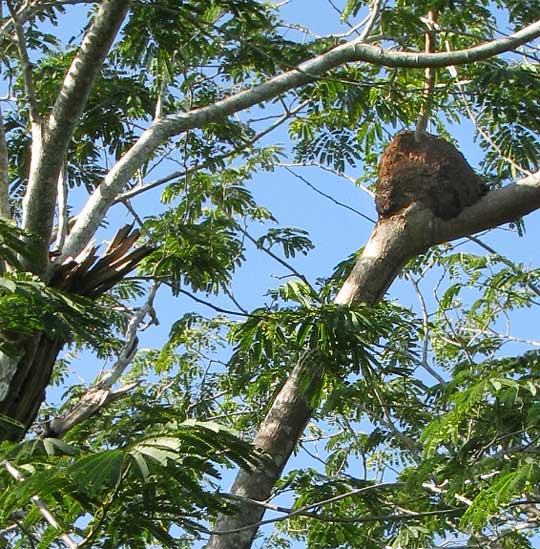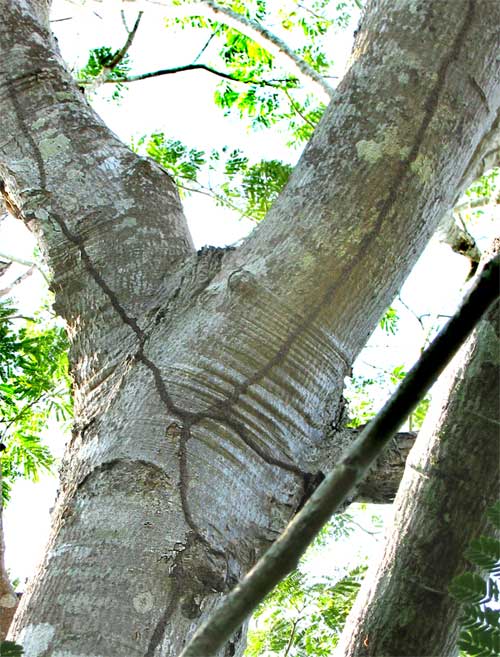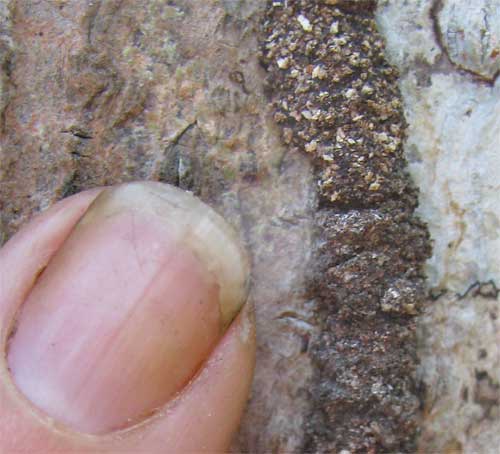Excerpts from Jim Conrad's
Naturalist Newsletter
from the September 8, 2008 Newsletter issued from Sabacché, western Yucatán, MÉXICO
ARBOREAL TERMITE NESTS
Out in the scrub you see brown, basketball-size termite nests on tree branches, like the one shown below:

Termites in such nests find most of the damp wood they consume on the forest floor. Since termites are plump, slow-moving insects bearing no stingers or particularly powerful pincers, the question arises as to how they commute between their arboreal home and the forest floor without getting picked off by predators. The answer is that they build covered pathways between their nests and the forest floor, such as those shown snaking down a tree's trunk below:

These covered highways tend to be placed on a branch's lower and/or shaded side. Such placement would keep tropical sunlight from heating things up too much inside the tunnel, plus the tunnels would be more protected from rain.
A close-up of a tunnel, showing how it appears to be made of glued-together sawdust particles, is below:

If you'd like to see inside an arboreal termite nest, meet various members of a termite caste system, and read about defensive and aggressive behaviors, go to https://cb.naturalsciences.be/ants/information/termites_arboreal.HTM.
from the May 24, 2015 Newsletter issued from Río Lagartos, on the Yucatan Peninsula's northern coast (~N21.60°, ~W88.16°), Yucatán state, MÉXICO
INSIDE AN ARBOREAL TERMITE NEST
This week I found an abandoned, broken-up nest with its insides visible, shown below in a Jabim tree:

Closer up, below, you can see how the interior consists of many interconnecting chambers and tunnels:

from the March 20, 2011 Newsletter issued from Hacienda Chichen Resort beside Chichén Itzá Ruins, central Yucatán, MÉXICO; limestone bedrock, elevation ~39m (~128ft), ~N20.676°, ~W88.569°
NO ARBOREAL TERMITE NESTS HERE
Here in the Chichén Itzá area such nests are absent. That's particularly interesting because you do see termite passageways consisting of glued-together sawdust particles snaking up trees' trunks.I couldn't imagine why arboreal termite nests might be common at Sabacché but absent here, in basically the same environment, so I asked my Maya friends on the ground crew.
"Parrots destroy the nests around here," one said, as if it were common knowledge.
It's true that parrots often place their own nests in termite nests, and I can see how this would upset the termites. Around Sabacché collecting wild parrots for sale as pets may have been responsible for there being fewer parrots there than here, so maybe that fact alone enabled termites to maintain their nests. Though here at Chichén Itzá there's also illegal parrot collecting, it's not nearly as aggressive as in most of the Yucatán, so maybe our higher parrot population has been bad news for termites.
So, you buy a parrot captured in the wild and you're funding the parrot-capturing industry, and your money ends up not only decimating the parrot population but also helping termites maintain their nests. Unintended consequences...
from the August 21, 2011 Newsletter issued from Mayan Beach Garden Inn 20 kms north of Mahahual; Caribbean coastal beach and mangroves, ~N18.89°, ~W87.64°, Quintana Roo state, MÉXICO
ARBOREAL TERMITE NEST, & OUR HAWK
Arboreal termite nests are conspicuous features of the landscape here. You can see a typical one in a hurricane-killed Poisonwood tree, with the immature Common Black Hawk we've been watching for months atop, below:

Such nests, which I'm guessing belong to the termite genus NASUTITERMES, are common in most of the Yucatán, though they become scarcer or disappear toward the arid northwest.
It's interesting that they were very common at Sabacché south of Mérida. At Hacienda Chichen it was hard to find a nest, though many big Piich trees had the termites' mud tunnels running up their trunks. Up there the Maya told me that parrots and parakeets nest in and destroy the nests, which sounds plausible, since parrots and parakeets are more protected in the ruin area and seem to be much more common than at Sabacché where they were hunted for the pet trade.
Here we have an opposite situation to that at Hacienda Chichen. Here plenty of nests are to be seen but so far I've found no mud tunnels leading from the ground up to the nests. Here we also have parrots and parakeets, but not as many as at Hacienda Chichen.
Someday figuring all this out will be a good project for a graduate student.